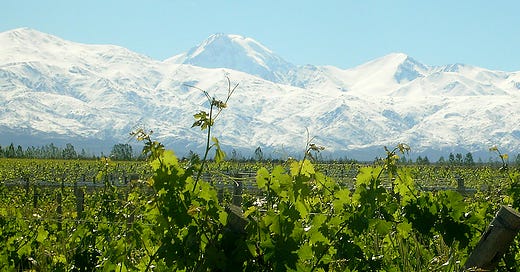This is the weekly newspaper column.
Mendoza Argentina 6-29-2022
If you drink Argentinean wine—who doesn’t, given its high quality and excellent QPR (quality-to-price ratio)—you likely have seen Mendoza on the label.
Mendoza is Argentina’s largest wine region—75% of the country’s vineyards. It has the most wineries—more than 1,200. It is a world-class producer of malbec and cabernet sauvignon.
Mendoza is a large province, 57,462 square miles, almost as large as Illinois. Located in central-western Argentina, the awe-inspiring, snow-capped Andes Mountains create a picturesque backdrop to its vineyards. They also play a crucial role in winemaking.
The Andes create a rain shadow, preventing wet Pacific Ocean weather from reaching Argentina. Instead, moisture falls as snow on the mountains. That makes Mendoza one of the sunniest and driest wine-growing regions on Earth with less than nine inches of rainfall a year. About the same as the Gobi Desert.
As a result, Mendoza is a virtual blank slate for growing wine vines. It is flat, sunny, and almost pest-free. Flatness means wine growers can use mechanical harvesters with ease—something vine growers in other areas, where vineyards are on the sides of mountains, can only drool over. With the labor shortage in the wine industry, this becomes even more important.
Then there are the snow-capped mountains. Snowmelt rivers provide arid plains with water needed for life. For vines.
Altitude is another God-given gift. Mendoza vineyards sit at 1,500-7,000 feet above sea level. That means more exposure to sunlight and UV during the day and a precipitous drop in temperature at night. A magic formula in winemaking. Heat and UV during the day drive ripeness. Cold at night engenders acidity. Great wines are a balance of ripeness and acidity.
Mendoza produces more malbec than any other place in the world. It also produces cabernet sauvignon, syrah, and bonarda. These grapes beget the lush, bold flavors wine drinkers covet.
Mendoza divides into five sub-regions: Maipu, Lujan de Cuyo, Uco Valley, San Rafael, and San Martin. There are nuanced differences in wines produced in each, but each is capable of producing outstanding wines.
Clearly this is a subject far too vast for a short column, but if you are into red wine, you almost certainly are into wines made in Mendoza. If you are not into Mendoza wines, try some to taste what you are missing.
Last round: When is a door not a door? When it is ajar. Wine time.
Email: wine@cwadv.com
Newsletter: gusclemens.substack.com
Website: gusclemensonwine.com
Facebook: Gus Clemens on Wine facebook.com/GusClemensOnWine/posts/
Twitter: @gusclemens
Links worth exploring
Diary of a Serial Hostess is a weekly column about the ins and outs of entertaining at home and witty anecdotes of life in the stylish lane. How-to's and advice from yours truly, the Serial Hostess.
As We Eat is a multi-platform storytelling project exploring how food connects, defines, and inspires.
Balanced Diet by Charlotte Rutledge is a rotating selection of original recipes, curated links pertaining to the food system, and recipe reviews.
















Share this post